Undermining Value
August 1, 2019essay,
In this research project, undertaken as part of the Koninklijke Academie van Beeldende Kunsten (KABK) Research Group 2018, artist Rachel Bacon explores the relationship between mark-making in drawing and in mining, hoping to develop a drawing practice capable of responding to the ecological crisis. Cultural theorist T. J. Demos believes that environmentally engaged art has the potential to address and rethink the complexity of relations between economics, politics, technology, culture and law.1 An alternative to this activist position – a more emotive practice, of adjusting to and mourning the effects of the calamity – is posited in the work of Timothy Morton and Heather Davis among others. During the past year Bacon has been investigating where and how her drawing practice is situated along this spectrum between activism and grieving
Temporal Disconnect

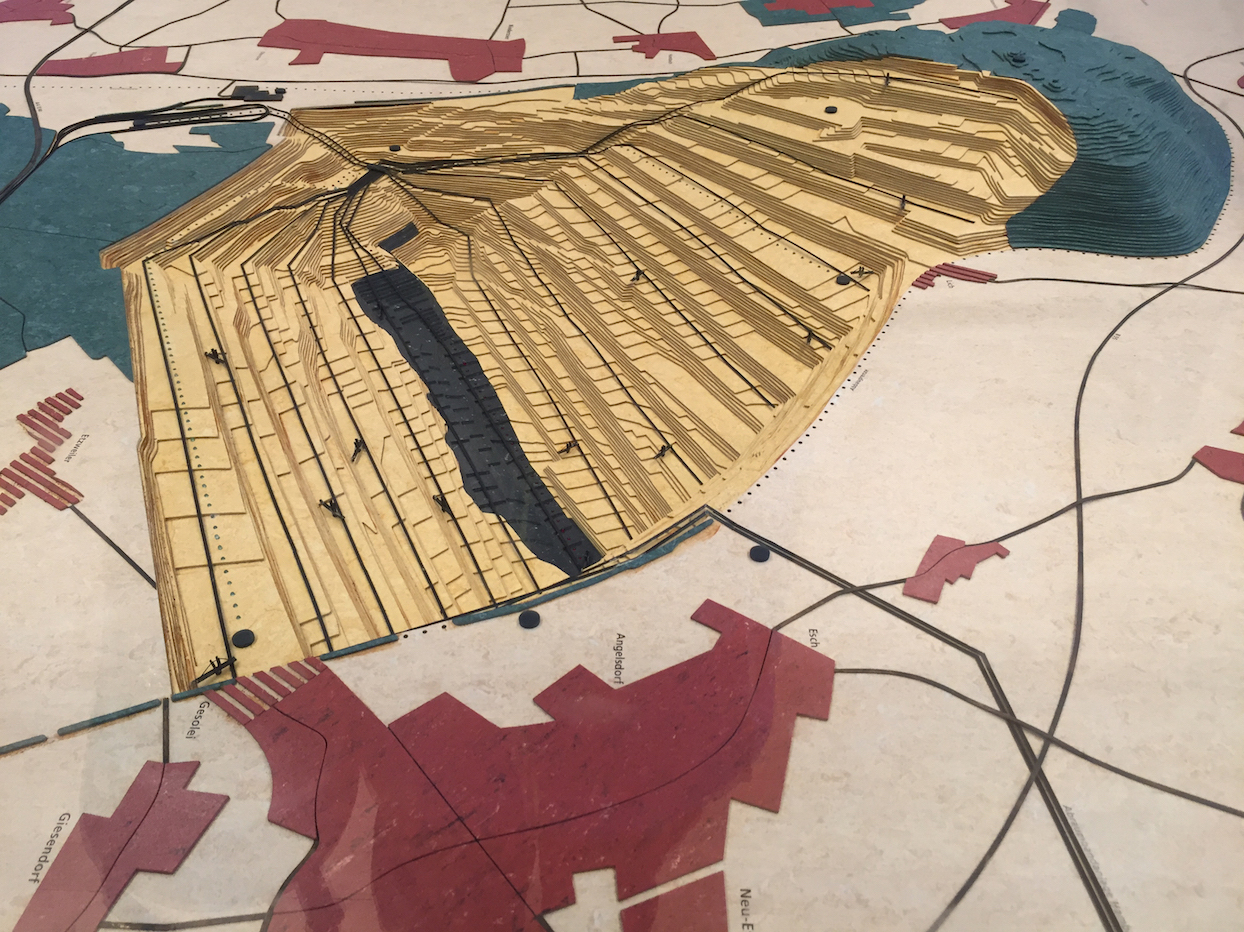
Despite the overwhelming nature of the ecological crisis, my initial reaction when confronted with an open-pit coal mine – surely one of the most physical and visceral symbols of climate change – was, I must admit, to be somewhat underwhelmed. Thinking about the relationship between the mark-making of drawing and mining had led me one cold, rainy week in November 2018 to Western Europe’s largest open-pit coal mine, near Cologne in Germany. This mine, the Tagebau Hambach, is one of a number of lignite (brown coal) mines in the area. It supplies fuel to the second and third worst polluters on Climate Action Network’s ‘Dirty Thirty’ list of the top CO2-emitting power plants in Europe.2
As I stood at the brink of the mine, I tried to make sense of it. At almost forty-five square kilometres of surface area, the mine is so big it almost resembles a feature of the natural landscape, like a river valley. Lignite, an especially dirty form of coal to burn, was created from ancient forests and bogs. The brown coal lies like a huge black stroke at the bottom of the mine, five hundred metres deep, only this drawing has been accomplished by massive digging machines. To get to the layer of brown coal, the excavators have to remove layers of topsoil, called ‘overburden’. This so-called waste material is used to fill in the hole left behind after the lignite is removed. There is nothing there with a scale remotely close to it giving an indication of its size. That is, until you see the tiny excavators and realize that in actuality they are three stories high. Then it starts to sink in. This spatial disconnect reverberates with the temporal one. The ancient plants that comprise the lignite have been lying there unaltered for thirty million years.
The first brown coal was mined at Tagebau Hambach in 1984. It is expected to run out by 2040. The immense time span of the lignite’s age stands in stark contrast to the pace of its depletion due to the economic imperative linked to growth and ‘efficiency’. The lignite is dug up and transported to be burned to generate electricity for among other things using toasters, charging devices, MRI scans and powering heavy industry. In flipping a switch lignite is often at the other end of the line. This is the other great disassociation; between the necessities and banalities of daily life and the materials that go into making them possible. These temporal and material disconnects, diffuse and almost impossible to grasp, have resulted in a focus in my work towards making drawings in which both extreme time-taking and tangible materiality play an important role. In the space between the ever-more-extreme gap between time and materials, I wish to place another kind of mark, that of physical fragility in the face of incremental time, to make the experience of the new era of overwhelming disconnect palpable.
Hyperobjects
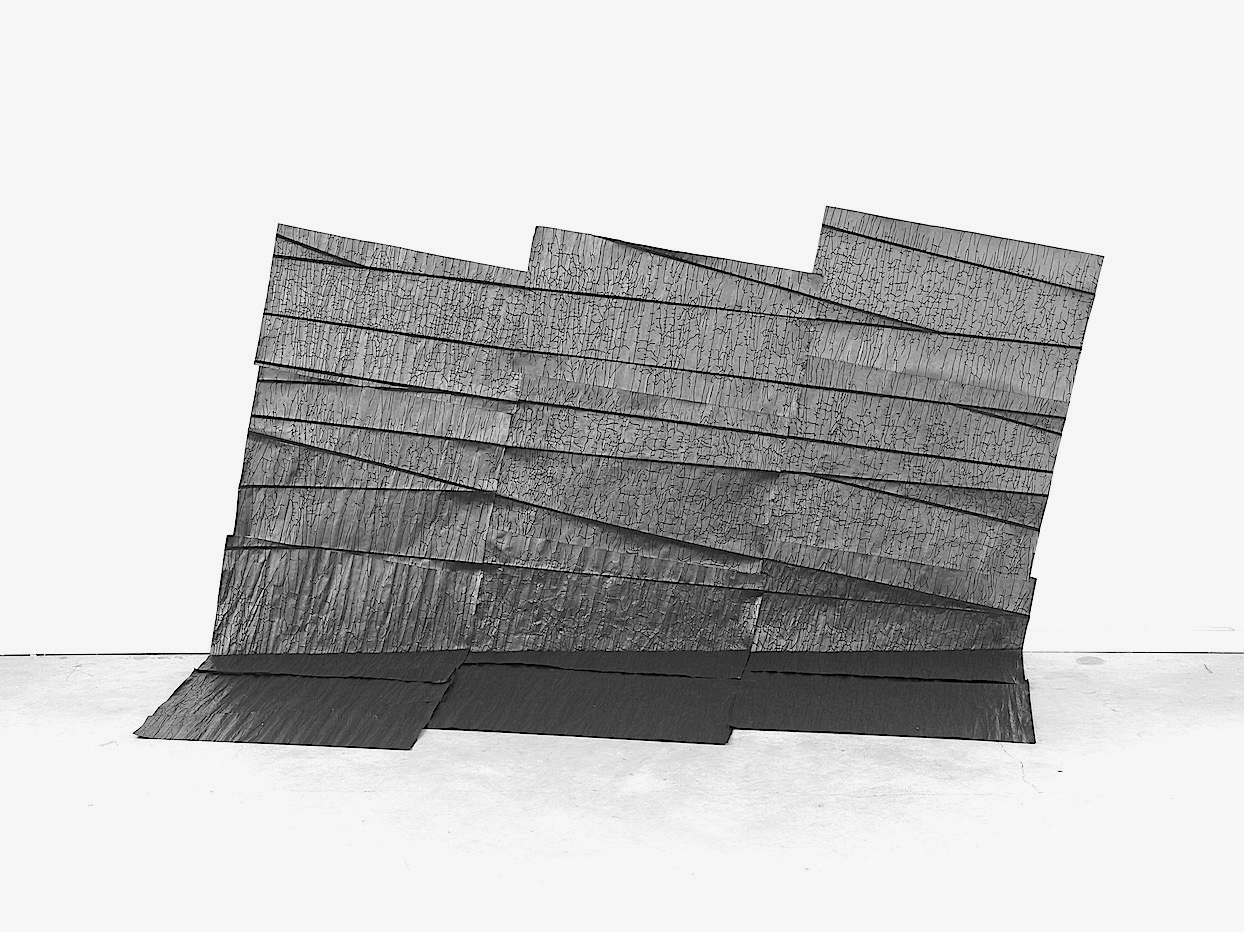
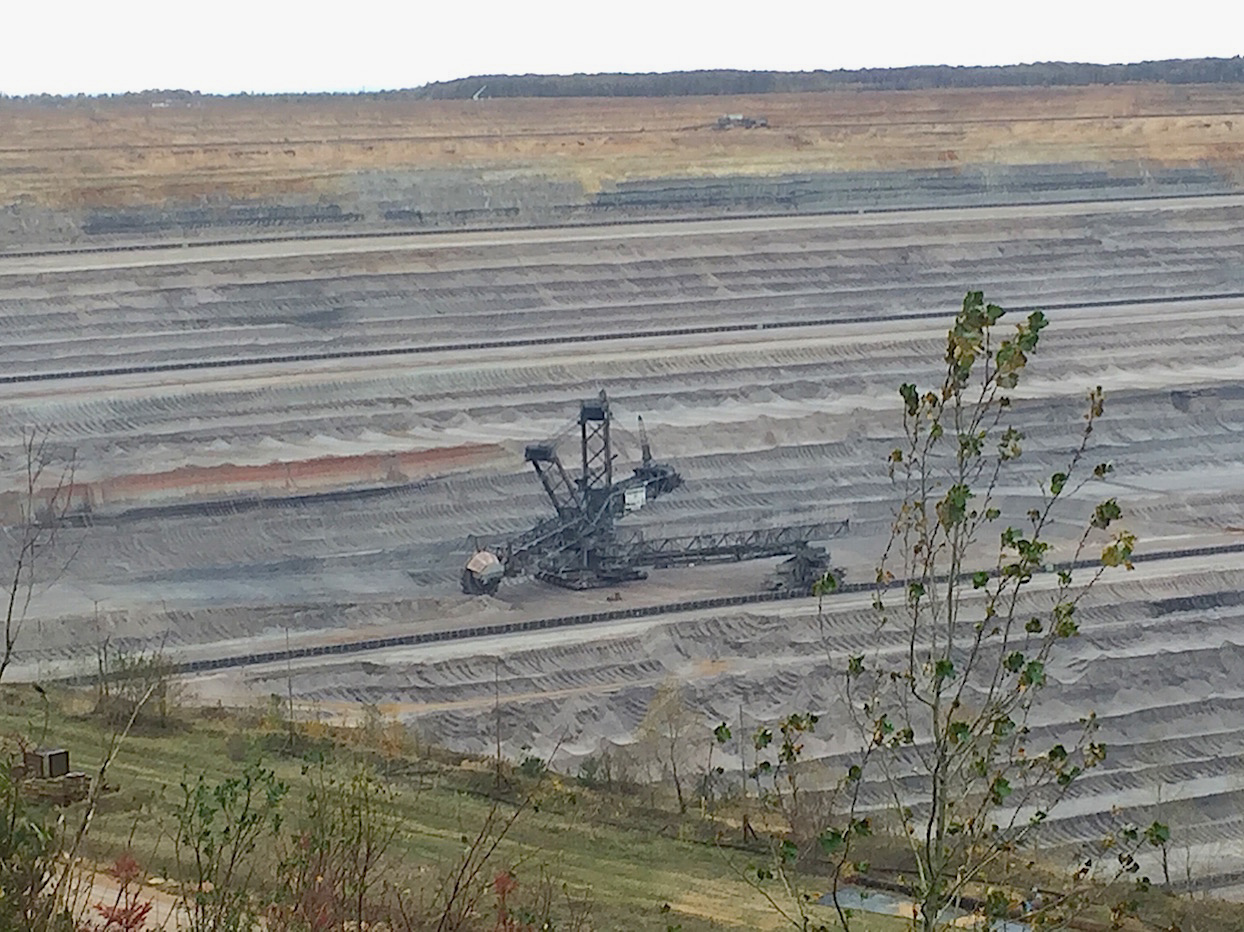
The radical disorientation in the face of the vast scale of ongoing ecological problems is described by Timothy Morton in Hyperobjects: Philosophy and Ecology after the End of the World (2013), a concept he uses to describe entities like global warming, pollution and radiation that are so immense in temporal and spatial scale that we are unable to grasp them even as they have a direct impact on our lives. For Morton, this means we find ourselves not just in an ecological crisis, but in an ontological one – what he calls a ‘quake in being’. The hyperobject is simultaneously distant and close, cycling in and out of our awareness, ungraspable but stuck to us. This has the effect of destroying conventional notions of World and Nature as a container for human lives. Without World and Nature as a backdrop, foreground, background and horizon also vanish, leading to a traumatic loss of coordinates. We are experiencing a period of catastrophic loss, not only literally, as we lose habitats and species, but also in terms of having to relinquish our old ideas of how we are in the world. For Morton, art in these conditions is grief-work.3 While extremely disorienting, this also leads to a state of intense intimacy with our surroundings, as we become aware of being very close with other entities. This situation will require an emotional response, as we can’t think our way out of this. The necessity of an emotive or intimate engagement with the painful reality of our predicament is also remarked on by researcher and writer Heather Davis. She refers to a deep unease at the rapid changes taking place, felt even by those without a direct connection to the natural world, as a form of ‘bodily knowing’.4 This is important, as art can make us aware of the identification between our bodies and the Earth’s body. Davis also notes the association that exists between polluting the Earth and polluting the body, and the notion of the self as porous and impossible to barricade off from the state of the world.
Alternative Excavation
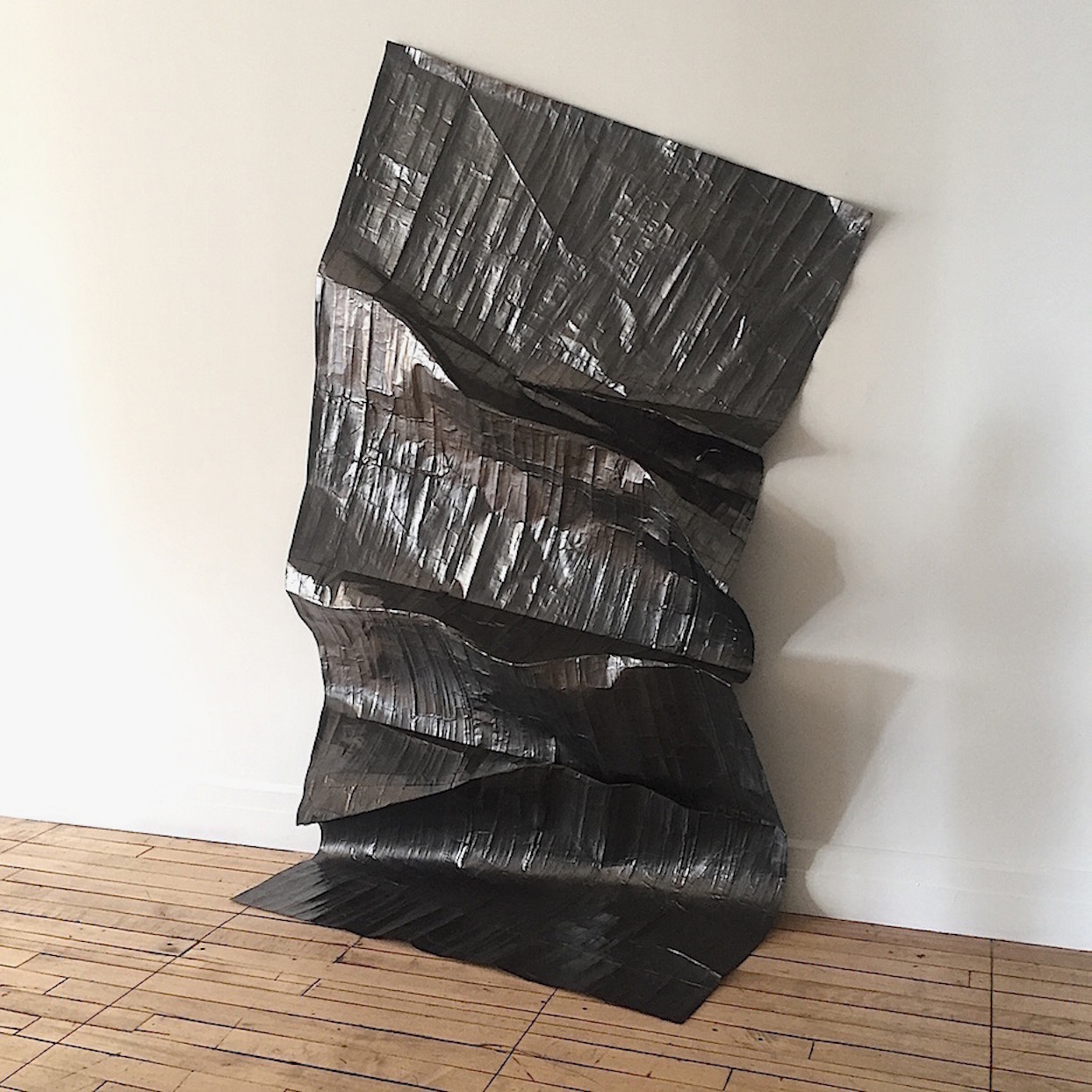
As Morton makes clear, one of the effects of the disorienting time we are in is an increased intimacy with the things surrounding us. And as an artist I strongly identify with the practice of having an intimate relationship with nonhumans. I often ‘make’ drawings; a kind of material drawing, hovering in between the second and third dimension, often with graphite on crumpled paper. Graphite, my main material, suggested a way forward in the research. Graphite and coal are allotropes of carbon, meaning they are in effect the same element, only expressed in different physical forms. This led me to thinking about the relationship between drawing and mining. Mining is of course central to the development of industrial capitalism, with fossil fuel extraction being an especially damaging form. The mine is not just a literal site of excavation, however, but also a metaphorical space. It has mythical associations with truth seeking. It is also conjured as a space of burial, hidden secrets and death. I have started to frame drawing as an alternative form of excavation, that becomes a space of the imagination instead of depletion. And might drawing become a means of returning extraction to its mythical association with truth seeking, and understanding of the Earth as a living body?
In the drawings I explore a shared methodology between drawing and mining. Both begin with a pristine site; a sheet of paper or a landscape. This is followed by mapping, or sketching. Then comes excavation, which entails destruction. The drawings are a way of spending time with this damage. I often draw on crumpled paper. Crumpled paper would normally be considered a mistake and thrown away. Here, however, the crumple lines in the paper are made visible through mark-making, in a kind of anti-drawing. This may involve drawing with a mechanical pencil around the lines in the paper so that the ridges of the creases emerge as lines. I see the undrawn part of the paper as a seam. It can be compared to a vein of coal, or ore. It isn’t a natural resource that is depleted. The undrawn paper becomes a space of potential that is never exhausted but reclaimed for the imagination.
It often takes many months to produce one of these images, an amount of time which is disproportionally large in comparison with the relentlessly efficient economic time of the mining enterprise. This extreme time-taking is an act of caring for a so-called failure, and a way of re-valuing something discarded. In mining, the discarded earth is called ‘overburden’, an unwanted leftover. In my drawing, nothing is discarded. I embrace what is unwanted and reveal mistakes through mark-making. The crumpled paper of the drawing gradually starts to resemble both skin patterns and the lands’ erosion, inviting an association with both body and earth. In this way, the damaged drawing invites an encounter and identification with the vulnerability and limits of materiality.
Drawing the Invisible Landscape
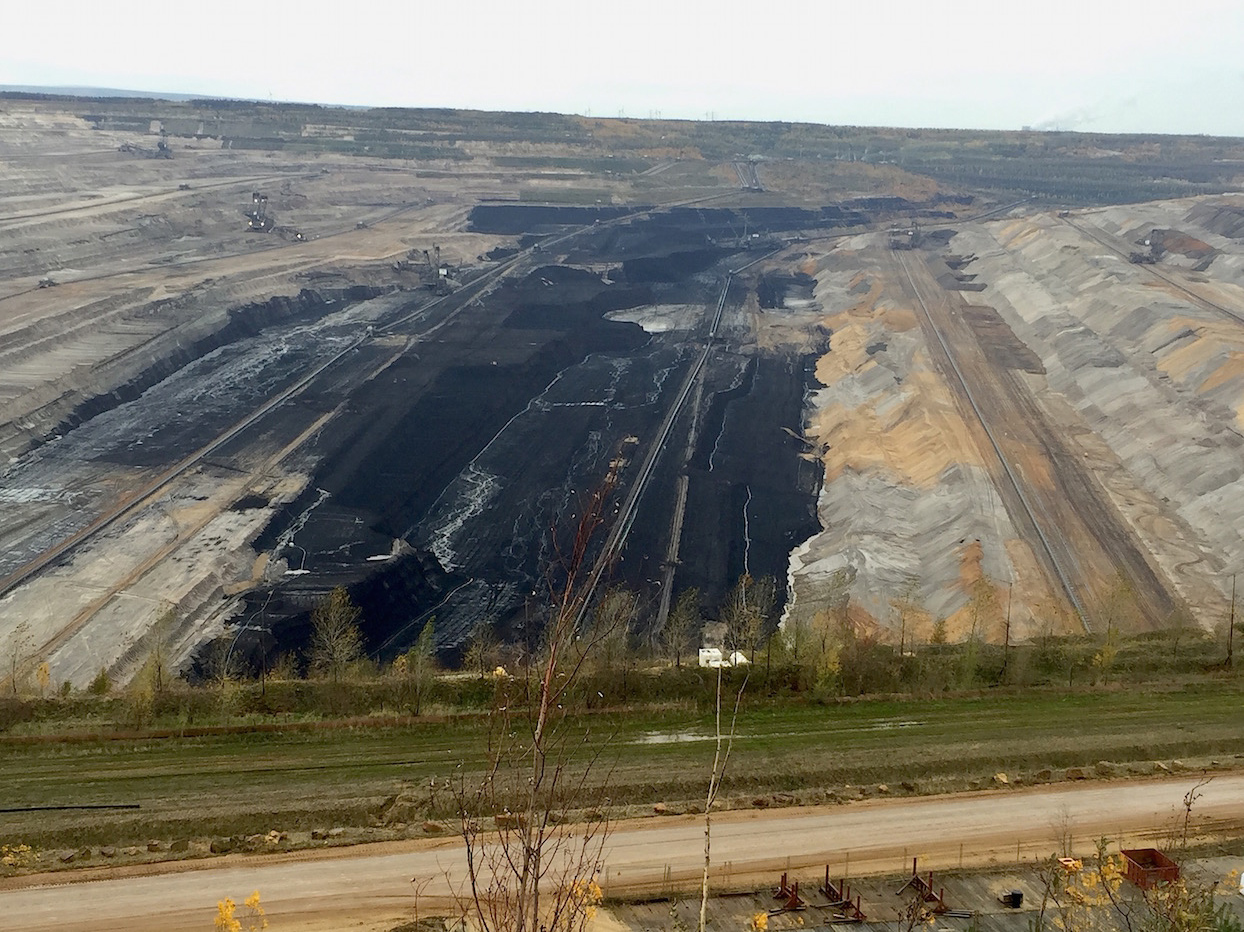
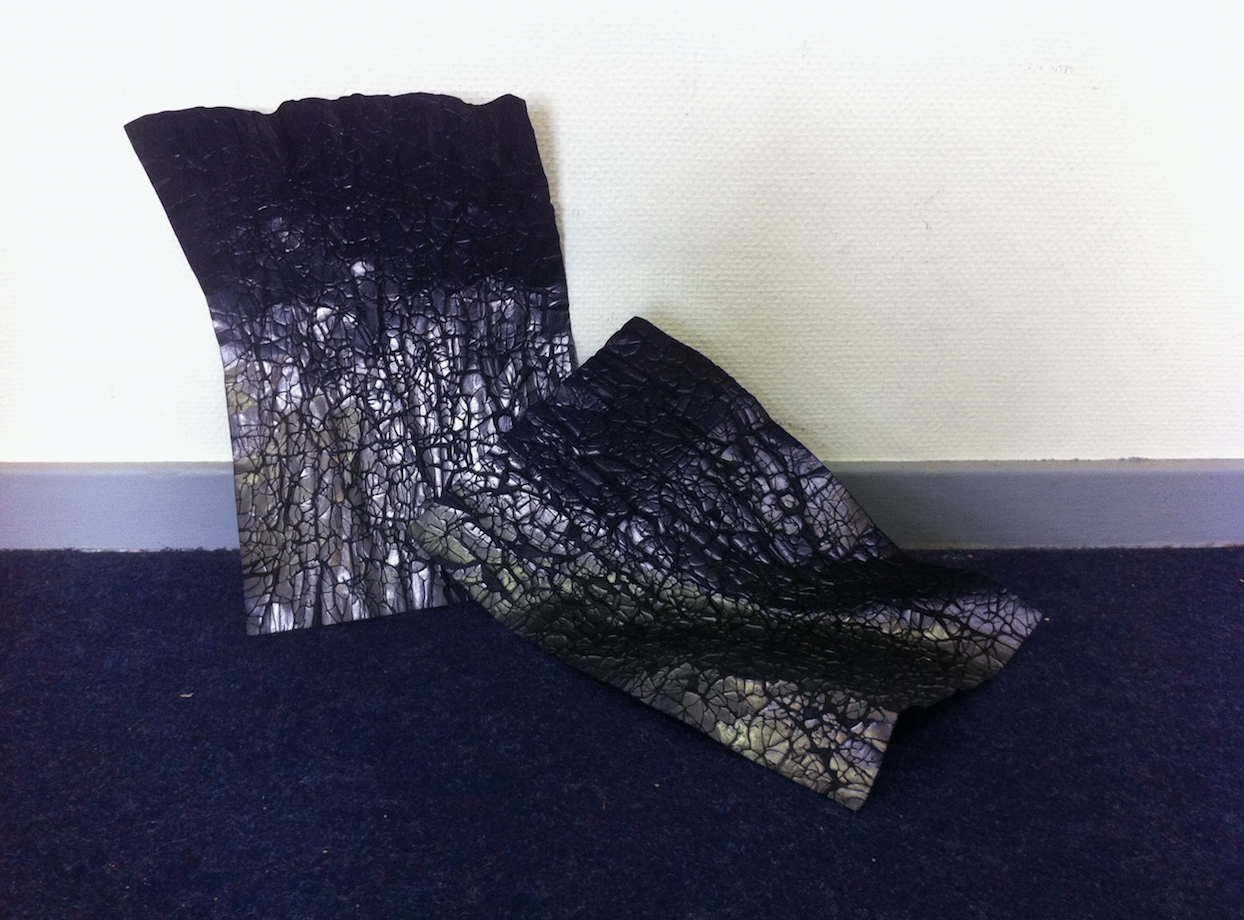
Much of the ecological crisis is a failure of the imagination. The consequences of human impact on the environmental are largely incremental, and often remain invisible. I have been exploring graphite rubbings as a new method that reveals something otherwise invisible. The graphite captures the impression of an underlying object combining presence and absence. The drawing remains, while the form that generates the image is missing.
In The Primacy of Drawing: Histories and Theories of Practice (2010) Deanna Petherbridge describes one of the overriding associations of drawing throughout time as being with gesture and touch. Drawn marks leave an ‘indexical record’, an evidence of the touch.5 This implies an immediate, intimate connection between bodies and their surroundings. Maurice Merleau-Ponty identifies the passion or speed of a mark as an artistic embodiment taking place within the domain described as intercorporeity. ‘This means that while each monocular vision, each touching with one sole hand has its own visible, its tactile, each is bound to every other vision, to every other touch.’6 Phenomenological looking is a form of touching, thus of mark-making; and through this looking and touching everything is interconnected. Drawing suggests the possibility that the Earth is looking back, and that marking the Earth is a form of drawing. Through gesture and touch, it might be possible to develop an ‘ecological’ practice, and new relationship with materials based on an awareness of interconnectedness with the surroundings. If, as in Eva Hayward’s wonderful phrase ‘haptic visual’, vision is configured as touch not distance, then to draw is also to witness.7
Acting – Drawing – Grieving
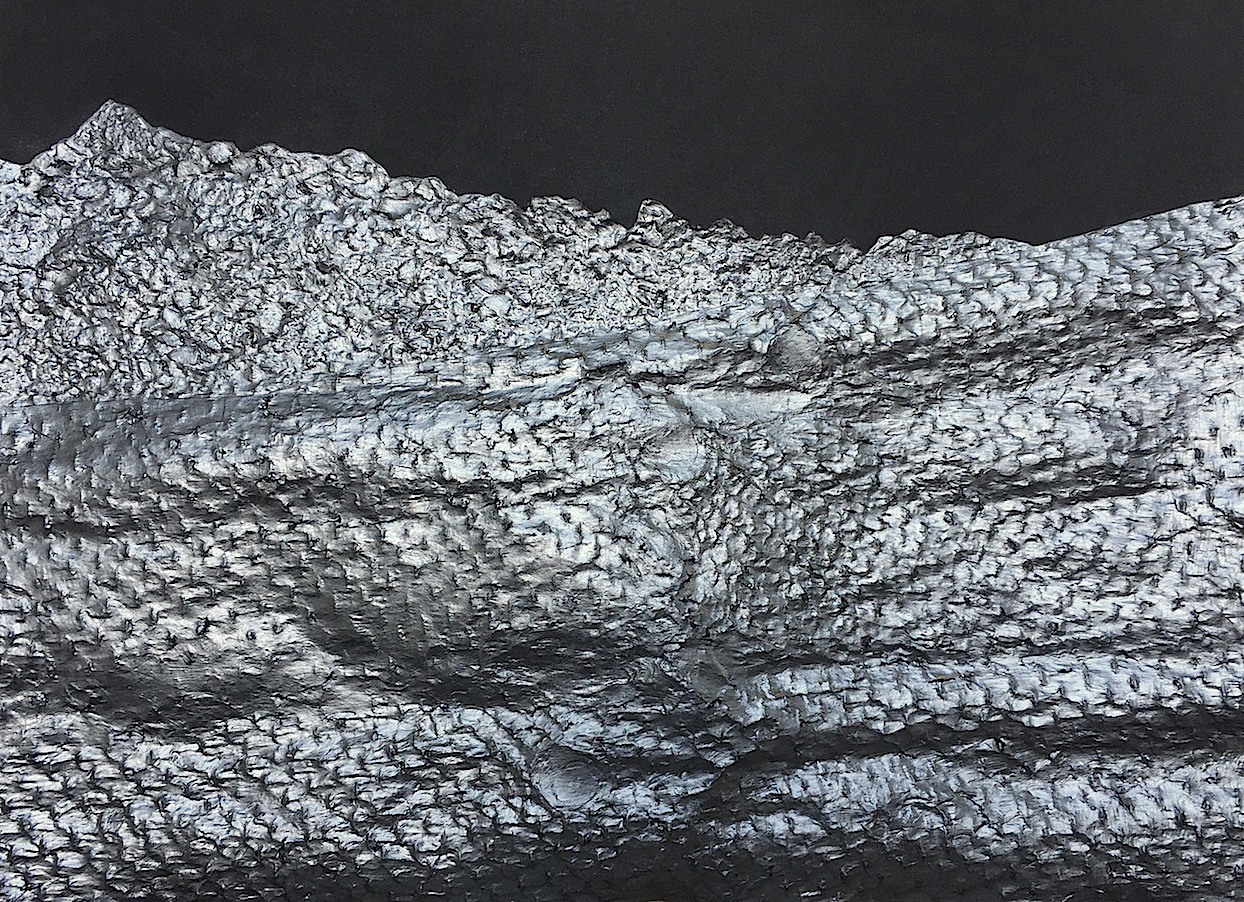
In an extension of Trebbe Johnson’s Radical Joy movement, in which people go to a place damaged by some human activity, and spend time with it, eventually making an artwork there or sharing a story about the place, my own work is moving towards immersion in a damaged landscape as a starting point.8 It might also be seen as a way of mourning loss. In historian Rosalind Williams’s formulation, physical nature poses a threat to power, as an emblem of a space free from human social order and subjugation. As such, it is destroyed not simply as a by-product of development, but for ideological reasons. ‘Therefore’, she writes, ‘mourning for the lost or ruined landscape is not necessarily a sentimental and outdated emotion. It can also express an ideological response to tyranny’.9
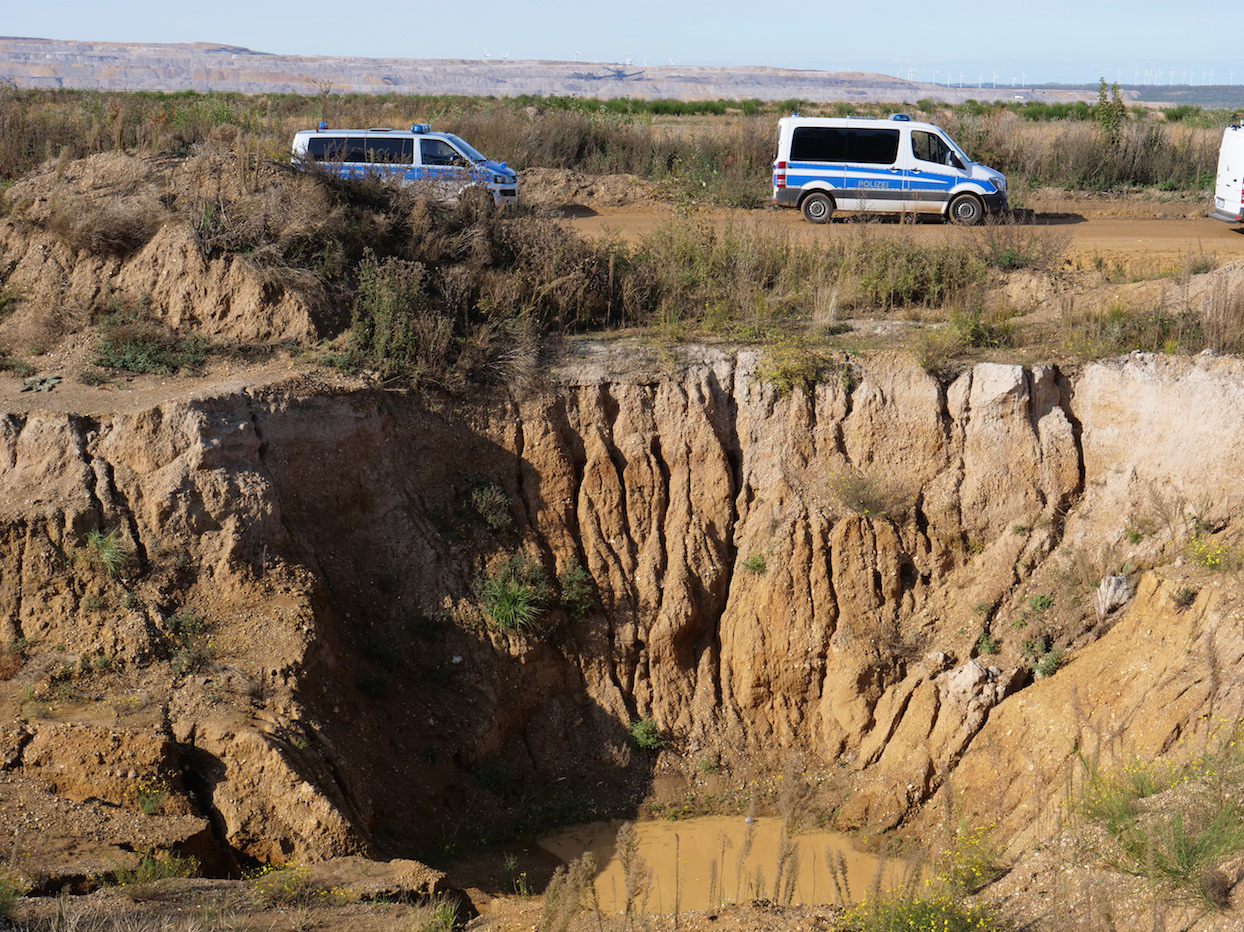
While visiting the Tagebau Hambach, I also spent some time in the forest at the edge of the mine near Buir, Germany. On the edge of the mine is a protest encampment, full of activists who have been living in the woods for the past six years, protecting the old forest from being cut down. They built and lived in tree houses that were destroyed by the mining company this past summer, as the forest was slated for destruction to make way for the next phase of the mine. There has been a reprieve though, as a German court ordered the mine to stop its expansion for the time being. These visits make the stark divide between the activists and the industry crystal clear. While I completely agree with the activists, who want to keep the coal in the ground and the trees alive, the black and white situation is also composed of innumerable tiny grey particles that are infiltrating the whole world. There is no going back to collect them all into a neat bundle, even if the last bit of the forest is saved (which I hope it will be). And while for me visiting the site is essential, as a way of remaining ‘exposed’, to encounter the difficult situation working locally also suffices as the damage is all-pervasive. Where and how to situate my drawing practice along the spectrum between activism and grieving will be my question in subsequent projects. In Morton’s words, a ‘profound political act would be to choose another aesthetic construct, one that doesn’t require smoothness and distance and coolness’.10 This is not about making ‘environmental art’. It is about not looking away. Making art in the presence of the scary thing.
1. T. J. Demos, Decolonizing Nature: Contemporary Art and the Politics of Ecology (Berlin: Sternberg Press, 2016), p. 8.
2. See ‘Europe’s Dirty 30: How the EU’s coal-fired power plants are undermining its climate efforts’, report, Climate Action Network Europe: European NGO coalition on climate and energy, caneurope.org.
3. Timothy Morton, Hyperobjects: Philosophy and Ecology after the End of the World (Minneapolis: University of Minnesota Press, 2013), p. 196.
4. Mirna Belina, ed., Living Earth: Field Notes from the Dark Ecology Project, 2014–2016 (Amsterdam: Sonic Acts Press), p. 235.
5. Deanna Petherbridge, The Primacy of Drawing: Histories and Theories of Practice (New Haven: Yale University Press, 2010), p. 104.
6. Maurice Merleau-Ponty, Basic Writings, ed. Thomas Baldwin (London: Routledge, 2004), p. 258.
7. Heather Davis and Etienne Turpin, ed., Art in the Anthropocene: Encounters Among Aesthetics, Politics, Environments and Epistemologies (London: Open Humanities Press, 2015), p. 258.
8. See Radical Joy for Hard Times, radicaljoyforhardtimes.org.
9. Rosalind Williams, Notes on the Underground: An Essay on Technology, Society and the Imagination (Cambridge, MA: MIT Press, 2008), p. 147.
10. Morton, Hyperobjects, p. 105.
Rachel Bacon is a visual artist and drawing tutor in the Fine Arts department of KABK and member of the 2018 Research Group chaired by Alice Twemlow. She has worked in project spaces and artist residencies, most recently Banff Centre for the Arts (2017) and MASS MoCA (2018). Her drawing practice with a specific visual vocabulary – paper, graphite, grid and crumple, developed during MA in Drawing studies at University of the Arts London in 2016 – considers the role of the artist in a time of ecological crisis and the value within damage in a space between 2D and 3D, image and object, standing and slumping. Her ongoing series, Emotional Landscape, explores seeing and constructing landscape framed by one’s emotional make-up, and the personal and social history folded into landscapes. Her work has recently been shown at: De Cacaofabriek, Helmond, Netherlands, 2018; Malonny, Lithuania, 2018; and Jerwood Drawing Prize, London, 2016–2017.